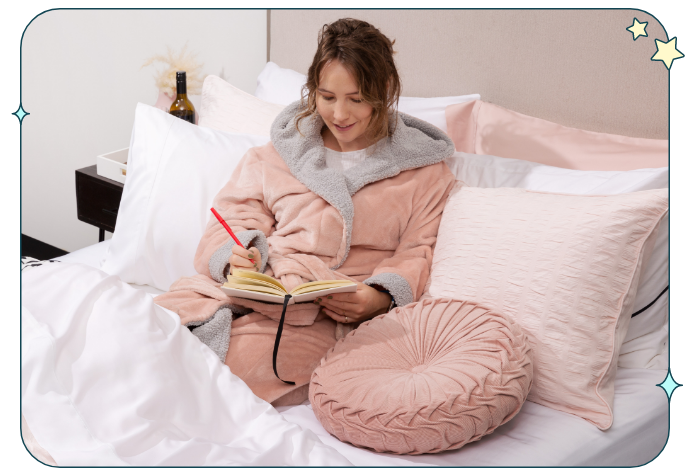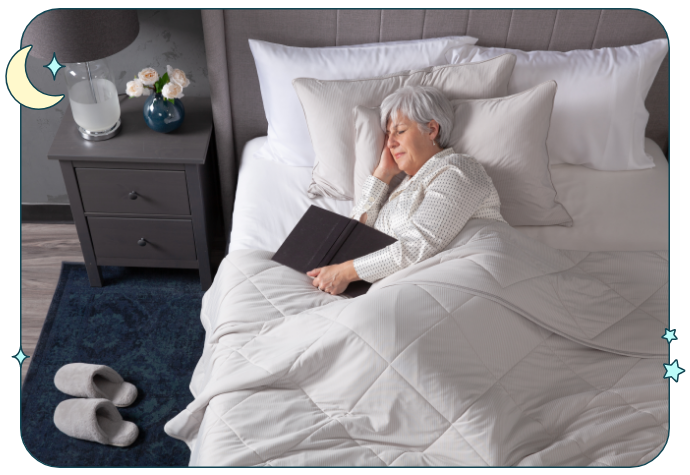Our Dream Guide To Starting Your Sleep Journal
2024 Aug 22nd
A deep, relaxing sleep might feel like a luxury, but it’s easy to forget that it’s also a necessity. It only takes a few rough nights to mess up your sleep schedule, and recovering from several restless nights often feels like an endless battle.
This is where sleep journaling can make a huge difference. This quick bedtime tradition gets you away from your screens and stress before you close your eyes, and helps you give a little dedicated care and attention to your sleep habits each night.
So, ready to get your nights back-on-track? Then let’s get journaling!

The Basics
A sleep journal is more than just a record of when you go to bed and wake up. It's a tool that helps you track various aspects of your sleep patterns and habits, offering valuable insights into what helps or hinders your ability to get quality rest. The short version is that you’ll take a little time in the morning to quickly fill it out, and from there you’ll be able to easily identify whatever’s disrupting your sleep the most!
This style of sleep journaling is a method recommended by Dr. Jade Wu, a clinical psychologist specializing in sleep. Her book, ‘Hello Sleep’, details how it’s important to quickly recognize patterns that affect your sleep, as your sleep could worsen over time if poor sleep factors go unchecked. It’s important to fix these obstacles fast and early to improve your sleep, and a sleep journal is an easy and effective way to get there.
With that, let’s talk about how to start a fresh sleep journal, and how you can use it to get the rest you need!

Getting Started
1. Pick Your Journal: The most important part of journaling, of course, is picking the journal that’s right for you! It can be as simple as a notebook by your bedside, or hidden within a dedicated app on your smartphone. We personally suggest a small paper book or a notes application on your phone, but what matters most is that it's convenient for you to use each morning, and small enough to keep by your nightstand, or hidden in a Bedside Felt Pocket.
2. Set Your Intentions: Before you begin, make sure you’ve got a clear goal in mind. Are you simply trying to improve your quality? Learn more about your insomnia? Improve your health and fitness? Get ready for daylight savings? Having a clear purpose will help you commit to filling out your journal without missing a day, and help you know what is (and isn’t) important for you to write down.
3. Get Tracking: From here, it’s all about filling out your journal! You should usually aim to fill it in sometime in the morning, ideally once you’ve fully woken up. That way, you can think about the quality of your sleep while it’s still fresh in your mind, and reflect on the night so you’re not dwelling about it just before bed.

As for what you’re putting into your journal each night, you’re plenty welcome to put down anything you think is helpful or relevant, Dr. Wu suggests noting down the following in each of your entries:
- Bedtime Routine: Write down everything you do as part of your full bedtime routine, and try to note the time with each step.
- Sleep Environment: Take note of the comfort and warmth of your bedding, as well as other aspects of your room like brightness and noise levels.
- Sleep Quality: Rate how well you slept and how long you were out. Be sure to include any disturbances or unexpected wakeups.
- Daily Habits: You don’t need to include a record of your full day, but jot down any factors like exercise, diet, or any exceptions to your usual routine.
- Emotional State: List out your moods, emotions, and any other thoughts that run through your head, both before and after bedtime.
How To Get The Most Out Of Your Sleep Journal
Once you’ve got a few entries, the next part is using them to discover where your sleep has room to improve. For a quick shortcut on what to look out for, here’s just a few common things we think you’ll notice going through your entries.
Identifying Patterns: By consistently logging all the details mentioned earlier, you should be able to spot trends and patterns by comparing each entry. Some of these can be fairly obvious, like finding you’re drinking caffeine too late at night. In these cases, it’s as simple as trying a new nighttime beverage, ideally something warm and soothing that’ll help you wind down.

However, others might be harder to recognize, like the amount of time between each step of your skincare routine. This can be hard to recognize, but if you’re spending time checking your phone or getting distracted, you might need to speed it up to avoid getting to bed too late. Even if a pattern seems innocuous, give it a little thought and see if you might benefit from a slight change.
Improving Sleep Hygiene: Beyond just the amount of time you sleep you need, it’s just as important to make sure you’re getting the quality of sleep you need as well. This is why it’s really valuable to record how you feel when you first wake up, since it’s easier to tell how well you slept when the feelings are most fresh.
For example, if you’re prone to allergies and find yourself waking up congested, it might mean your sheets are due for replacement 一 preferably a fabric that’s hypoallergenic and antibacterial, such as our Bamboo Cotton with Activated Charcoal or Mulberry Silk bedding. Or, if you find yourself waking up too warm, the heat might be keeping you from getting a deep sleep, in which case you may want to lighten your layers with a refreshing cooling blanket or a breathable cotton quilt set.
Reaching For Mindfulness: The act of journaling itself encourages mindfulness and self-reflection, but it takes a lot more than a journal to balance your mental state. If you’re feeling stressed or depressed when you go to bed, those feelings won’t always go away when you wake up, and one of the best ways to get out of a rough state is to show yourself a little extra love.
Adding a self-care routine to your night is a sure-fire way to help, but it can often be enough to simply add a little extra self-care into your regular evening. If you find you’re still in your work clothes most of the day, try changing into a light and comfortable bathrobe to give your body a lighter, softer sensation.

If you don’t have time for the long skin and hair care routine before bed, you can also toss on a Mulberry Silk Hair Wrap or Bun Cover during the night to say goodbye to those gnarly lines and frizzy hair, or even rest your head on a luxurious Silk Pillowcase for the same wonderful benefits. Simply put, you can treat yourself without too much effort, a few little things can truly go a long way!
The road to better sleep is different for everyone, but a sleep journal serves as a road map to navigate the obstacles getting in the way of that well-rested feeling. We wish your luck on your cozy journey, and hope this guide has helped you discover your new dream routine.
For more tips on getting quality rest you need, explore our full blog and discover how you can make every night feel like a dream. Plus, visit any of our 70+ locations across Canada, and our sleep experts would be happy to help you perfect your sleep even further. Sleep tight!

